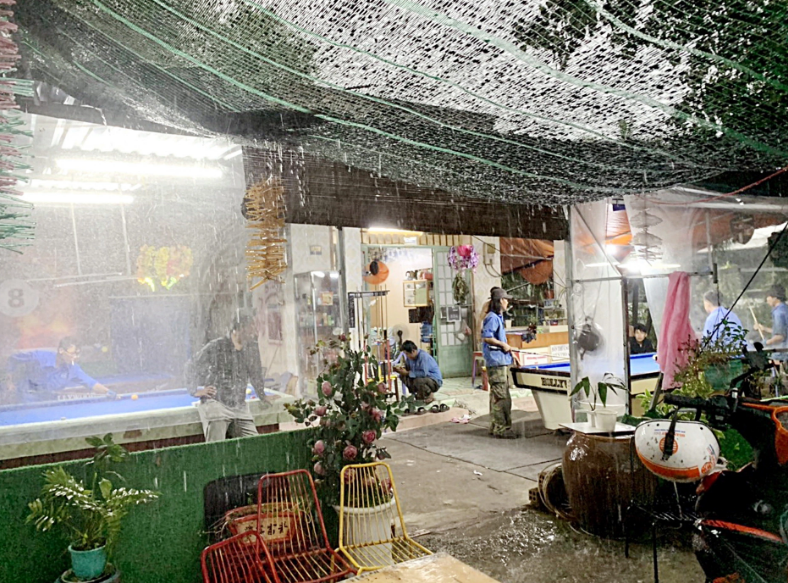Residents in the Phu My Hung New Urban Area in District 7 and some areas in the south of Ho Chi Minh City have voiced their outcry over a foul odor from the nearby Da Phuoc landfill in the past few days.
The repugnant smell from the dumpsite is haunting these dwellers and badly affecting their daily activities.
The Ho Chi Minh Department of Natural Resources and Environment had earlier pledged to curb the stench by 2024, but the smell pollution in the area has yet to improve.
Nearly 10,000 metric tons of waste is discharged in Ho Chi Minh City daily, which is treated at the Da Phuoc Waste Treatment Complex in Binh Chanh District and the Tay Bac Solid Waste Treatment Complex in Cu Chi District, according to statistics from the municipal department.
The Da Phuoc landfill developer Vietnam Waste Solutions Ltd. (VWS) has constantly faced complaints about the stint from the landfill over the past many years.
When the city enters the rainy season starting from May, followed by the southwest wind, residents living in its southern region, including the Phu My Hung New Urban Area in District 7, the Da Phuoc urban area in Binh Chanh District and Nha Be District, concurrently suffer the disgusting odor from the landfill.
The unbearable smell goes with the wind and penetrates into residents’ houses.
Quynh Nhu, a resident of Tan Phong Ward in District 7, told Tuoi Tre (Youth) newspaper that she is suffering a headache caused by the stench from the Da Phuoc landfill.
“The unpleasant smell does not exist for a short time, but dangles in the air. On sunny days, the disgusting odor often appears in the evening,” Nhu said.
“Meanwhile, on rainy days, the wind brings the foul odor to residents’ houses. If I forget to close the door and windows, my house is smelly for half an hour."
Nhu is putting her house on sale two years after her family moved to the current residence from Thu Duc City, and suffered the foul odor.
VWS was assigned to treat up to 6,800 metric tons of waste every day at the Da Phuoc landfill using the burial method.
The problem related to the stench from the dumpsite is not new.
Over the past few years, the city’s relevant agencies and the Ministry of Natural Resources and Environment have checked and handled the smell pollution many times.
In addition, VWS has adopted multiple measures to eliminate the foul odor, but in the rainy season, coupled with the southwest wind, residents in Phu My Hung and other nearby districts unavoidably suffer the polluted air.
|
|
| Quang, owner of a coffee and billiards shop, says that he must cover his shop with nylon sheets to prevent dust and noise when garbage trucks travel to the Da Phuoc area in Binh Chanh District, Ho Chi Minh City. Photo: T.T.D. / Tuoi Tre |
The leader of the Department of Natural Resources and Environment said that the burial method could not handle the foul smell.
As per the national environmental protection strategy passed by the prime minister, the percentage of buried waste in urban areas must be lowered to 30 percent by 2025 and to 10 percent by 2030.
Ho Chi Minh City aims to reduce the percentage of buried waste to 20 percent in 2025 from the current 70 percent, and completely switch to the waste-to-energy technology in 2030.
To fulfill the goals, a solid waste treatment factory developed by Vietstar JSC and a waste-to-energy facility invested in by Tam Sinh Nghia Investment Company got off the ground in late 2019.
The two plants, located in the Tay Bac Solid Waste Treatment Complex, were slated for completion in late 2020, but they lagged behind schedule.
Instead, the completion of the work on the two facilities was extended to 2025. When in place, the two will treat a combined 4,000 metric tons of waste a day.
The city is expected to discard 13,000 metric tons of waste daily in 2025, while the volume of waste might reach 16,600 metric tons per day in 2030.
Director of the Ho Chi Minh City Department of Natural Resources and Environment Nguyen Toan Thang said in 2020 that the Da Phuoc landfill would shut down in 2024.
To maintain the operation of the dumpsite, VWS was told to shift to the waste-to-energy technology from the burial method. With the modern method, some 3,000 metric tons of waste will be treated daily.
Speaking of the chronic foul odor from the Da Phuoc landfill, Dr. Pham Viet Thuan, head of the Institute of Economics and Environmental Resources in Ho Chi Minh City, said that given the worsening situation, the city should close the landfill as soon as possible.
The dumpsite has badly plagued residents in the south of the city for several years, while VWS is in the process of completing a report on its investment in switching to the waste-to-energy method.
The project will take much time.
After the Da Phuoc landfill is closed, waste should be transported to the Tay Bac Solid Waste Treatment Complex in Cu Chi District where there are a few residential areas pending the completion of hi-tech treatment infrastructure, said Dr. Thuan.
Like us on Facebook or follow us on Twitter to get the latest news about Vietnam!



















































